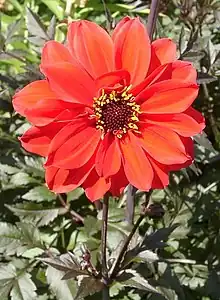Dahlia 'Bishop of Llandaff'
'Bishop of Llandaff' is a cultivar of the dahlia, a garden plant. It is a branching, tuberous tender perennial with dark purple, almost black, foliage. This produces a stunning contrast with its scarlet flowers.[1] The plant was first bred by Fred Treseder, a Cardiff nurseryman.[2] It was selected by and named to honour Joshua Pritchard Hughes, Bishop of Llandaff, in 1924 and won the RHS Award of Garden Merit in 1928. The plant is about 1 m tall and flowers from June until September. As with all dahlias, frost blackens its foliage, and in areas prone to frost its tubers need to be overwintered in a dry, frost-free place. The variety became very popular in the 1990s.[3]
| Dahlia 'Bishop of Llandaff' | |
|---|---|
 | |
| Species | Dahlia ×hortensis |
| Hybrid parentage | D. coccinea × D. pinnata |
| Cultivar | 'Bishop of Llandaff' |
The simpler form (single or semi-double)[1][3] of the flower makes the nectar and pollen more accessible to pollinating insects.[4]
A seed strain has been produced from this plant called 'Bishops Children', they retain the dark foliage colour but produce a mix of flower colours and flower shapes from single to semi-double flowers in different sizes.
Plant Profile:
- Height: 1.1 m (3+1⁄2 ft)
- Spread: 45 cm (18 in)
- Site: full sun
- Soil: fertile, free-draining
- Hardiness: half-hardy
Also comes in rich reds and purples, yellows and oranges, as well as paler shades
References
- Szerlag, Nancy. "Gardening: Old-fashioned dahlia a stunner". The Detroit News. Archived from the original on 28 May 2023. Retrieved 13 October 2023.
- Bourne, Val (30 September 2013). "My dahlias are brightening up September". The Daily Telegraph. Archived from the original on 10 October 2013. Retrieved 20 October 2013.
- Vernon, Andy (2014). The Plant Lover's Guide to Dahlias. United Kingdom: Timber Press. p. 7.
- Dowdall, Peter (3 April 2022). "The perennials that will lead to masses of colour". Irish Examiner. Archived from the original on 27 April 2022. Retrieved 13 October 2023.